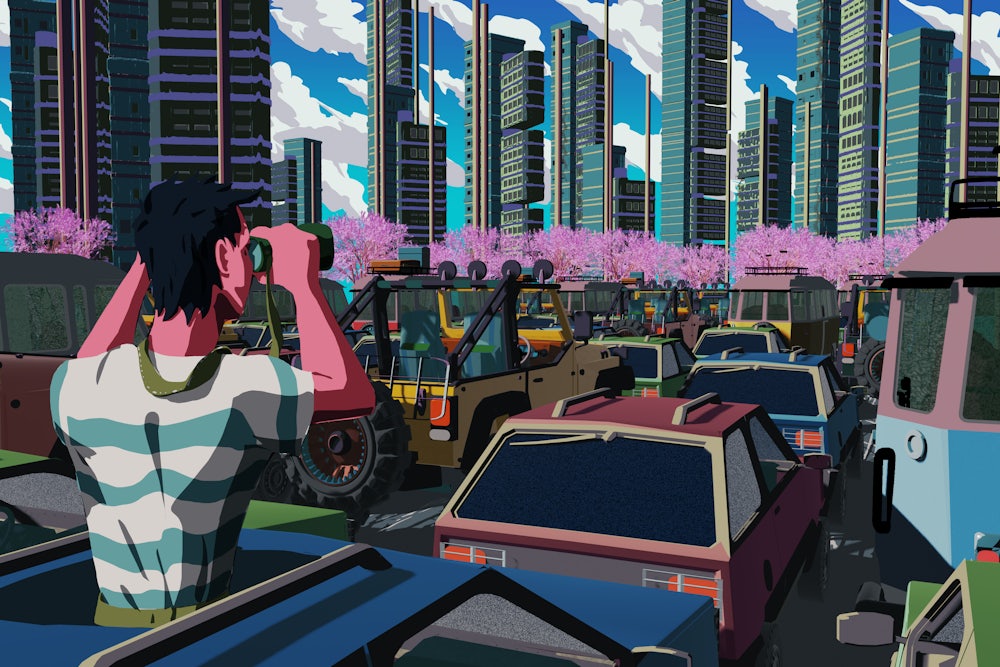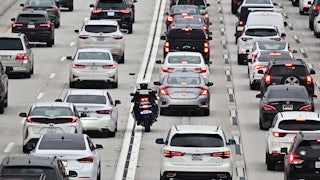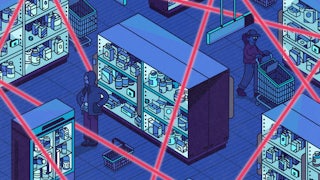Americans are in a toxic relationship with their automobiles. They’re bad for us—polluting, noisy, and increasingly dangerous to pedestrians—yet we remain fully committed to them. They’re also bad at their primary function: transport. Urbanists and environmentalists for years have proposed solutions to break the automotive spell: improved mass transit, walkable cities, congestion pricing. But cars (and their companion scourge, parking) still dominate our public spaces. On episode 66 of The Politics of Everything, hosts Laura Marsh and Alex Pareene talk with authors Daniel Knowles and Henry Grabar about the obstacles that prevent us from constraining car culture—and, perhaps, a solution.
Laura Marsh: If you
went to see the cherry blossoms in Washington, D.C., this year, you might have
been disappointed, but not because the trees weren’t beautiful or the weather
was bad. The simple problem was logistics. On
one particularly nice day in March, drivers got stuck on their way into the
park for up to four hours. Some started to
tweet about their frustration, and others called their local radio station.
Many of them never even got out of their cars. Alex, you wrote about
this incident a few weeks ago. What went wrong?
Alex Pareene: Well, it was a perfect storm of traffic conditions. It was peak cherry blossom. Every year there’s this period when the cherry blossoms all bloom at once. It’s very beautiful, and that weekend is the most popular time to go see them, obviously. Basically, every driver in the D.C. metro area was trying at the exact same time to go to the exact same place, which is around the Tidal Basin, down by the monuments and East Potomac Park, down by Hains Point, essentially a peninsula in the Potomac, where drivers were trapped in the road that does a circle around it, and perhaps that could have been avoided if they had closed that one road to traffic instead of allowing everyone to drive on it.
Laura: I am trying to imagine what all these beautiful cherry trees covered in flowers would look like with the backdrop of station wagons and sedans, cars everywhere. All the conditions were in place for a very nice day, and then it just turned into this incredibly aggravating experience.
Alex: Right. People were stuck for hours and then because the traffic wasn’t moving, they started just abandoning their cars. They were getting out in the middle of the road, causing even more congestion.
Laura: You calculated that it would be quicker to take public transit from New York City to these cherry blossoms than to drive there from within the D.C. area. How would you make that work?
Alex: I based that on at least one report of a person sitting in their car for four hours. I could go hop on the subway, get to Penn Station in 40 minutes or so, and then take the Northeast Regional, not even the Acela, and get down to D.C. in about three and a half, maybe four hours. And then from Union Station just hop on a bike share, get down to Haines Point in East Potomac Park. That’s about a 20-minute ride on a beautiful, beautiful day. So I would’ve gotten from my home in Brooklyn down to where all these people were trying to drive in about the same amount of time it took them.
Laura: So it’s not actually that hard to beat the crowds. In fact, the D.C. police issued several traffic advisories this year about the cherry blossoms specifically, urging people to walk, take the bus, bike share. There’s a whole list of suggestions where they’re saying, “Please do anything but drive.” But somehow people didn’t.
Alex: Yeah. It’s important to make it clear that the place all these people were trying to get to is not in the middle of the desert or out in the suburbs, or the Grand Canyon. It’s in a dense city. It goes to show that this is a predictable traffic event that happens every year, in a place with a lot of mass transit, a place where you can easily walk to all of the sites you need to see, a place where you can easily bicycle too. These official responses, begging people not to drive, are obviously insufficient. I don’t think it’s because all of these people stuck in traffic decided to ignore the warnings. It’s just that car dependence was so ingrained in them, they just didn’t think of an alternate way to go.
Laura: Today on the show we are talking about cars, our devotion to them, even when they make our lives worse.
Alex: What could be the Achilles’ heel of car dependence, the secret weapon we could use to rein it in? I’m Alex Pareene.
Laura: I’m Laura Marsh.
Alex: This is The Politics of Everything.
Alex: Cars are useful. For proof, look no further than the 290 million vehicles traveling on American roads, more than one for every adult. Driving them also drains our finances, increases the time we spend in traffic, puts us at risk of crashes and poisons the air. We’ve known all this for decades, so why have we only ever doubled down on our devotion to them? In his book, Carmageddon, Daniel Knowles, a correspondent at The Economist, maintains that our automobiles are essentially driving us and the way we live, not the other way around. They are what the city you live in looks like and what your daily life feels like. Daniel says, “The car goes to the core of almost everything, dominating almost all public spaces.” Daniel, welcome to the show.
Daniel Knowles: Thank you ever so much for having me on, Alex.
Alex: One of the things you argue is that even if we think we put up with those negatives for all the positives that cars give us, a lot of the things that we think cars do well, they’re actually not that great at. What are some examples of that phenomenon?
Daniel: Just getting around for one. If you are the only guy with a car in your city, then a car is brilliant. But when everybody’s got a car, you’re just stuck in traffic. They’re not that good for getting around. They’re unpleasant and stressful, when you are dealing with everybody else. The problem with drivers is there’s too many of them.
Laura: So the obvious solution to too many cars, too many people stuck in traffic, is the roads are too narrow, add some more lanes. How has that affected American cities? Does it work?
Daniel: It does not work, obviously. The thing about adding lanes is you widen the roads. More people drive, everything gets further apart. As stuff moves further down the roads, you get just as much traffic as before. Eventually every other way of getting around becomes implausible because your entire world is just roads and parking and everything that you need to get to is at least a mile or two away. The apogee of that is somewhere like Houston, where doing anything on foot is almost impossible. Everywhere is separated from everywhere else by cars that are all moving really fast. There’s videos on YouTube and TikTok actually of people trying to walk distances that are on paper, not very far in Houston, two or 300 yards in a straight line—
Laura: I have made this very mistake, literally when I was staying at a hotel for a conference and I thought I’d walk over to the conference center and discovered there was no sidewalk. I was stepping along a grassy verge on the way to this thing and had to cross several intersections and realize, Oh, this actually just isn’t somewhere that you can walk. I would maybe have had to book a taxi for this ten-minute journey. It’s hard to be a pedestrian, but what about if you are in the cars? How have cars changed in the last 10, 20 years?
Daniel: The big thing that’s happening with cars now, obviously other than becoming electric, is that they’re getting bigger. SUVs, these very luxurious pickup trucks that people use to go to Walmart or whatever. The vehicles now are a lot heavier which makes them noisier, more polluting, and a lot more dangerous to pedestrians.
Laura: Twenty years ago, I remember at least there being excitement around smaller cars, things like the smart car. The idea was this will be great because you’ll be able to slip into the little parking space that no one else can fit their car into. But actually, what’s happened is the trend toward bigger and bigger cars. What do you think has been the appeal of the SUV?
Daniel: The appeal of the SUV is we’ve had a period of very cheap gasoline prices. The other thing is just that every other car on the road is giant. I don’t know if you’ve ever driven a smart car. I did once, and when you are surrounded by pickup trucks, and you feel scared in one of those small cars, some giant pickup truck will just go right over you.
Alex: When you’re on the freeway, you’re not sure if the semitruck can see you in the mirror or not. Now it’s like that with almost every passenger car on the road if you’re in what used to be a normal-size compact car.
Daniel: It’s basically a terrible prisoner’s dilemma type thing where you are forced to buy a car and then you’re forced to buy a much bigger car because of everybody else getting one.
Alex: That’s the really interesting part. I think in the United States, this idea that having one gives you the freedom to go wherever you want, but you are describing a situation in which everyone is forced into a car.
Daniel: Yeah, I’m trying to make the case on an American freedom basis. Right now, you’re forced not only to use a car. You’re also forced to pay for parking spaces whether you use them or not. You’re forced to pay taxes that go on roads, whether you drive on them or not because the roads aren’t funded by gasoline tax anymore. So there’s a lot of ways you’re forced to pay for this car, whether you want to engage it or not.
Laura: When you criticize people’s cars, even if they feel trapped when they’re in traffic, and even if they don’t like paying for gas and all this stuff, or they hate finding parking, they themselves can feel very criticized. Have you had any angry reactions to some of the reporting you did in the book or to the book itself?
Daniel: Do you know? Honestly, less than I thought. Which I’m hoping there’ll be more, because it means that maybe I haven’t been read enough by the right kind of people yet. But I think people can simultaneously agree with you and disagree with you. If you have bought a car and you’ve spent an awful lot of money on it, the idea that increasing the cost of gasoline or putting a toll on the road or taking away parking spaces do get people very upset by that because they think, “God, I’ve already got this car and it’s already hard enough and you want to make it harder.” I think it’s explaining the link between making car use harder and making other forms of transport easier. That often bumps into people’s worldview.
Alex: That’s actually a good way to get into why the politics of this are so hard. An author like you can make this case at length and at book length, in fact. It’s much more challenging for a politician, because when you say, a world with fewer cars would be more pleasant in general for all of these reasons, it’s hard to get people to imagine an improvement on the status quo as opposed to having something taken away from them.
Daniel: Absolutely. People have massive loss aversion. Look at this argument in New York about the congestion charge. That is not people in general, but, specifically, the drivers who are very upset about it, as though they’re going to be banned from Manhattan forever. “Oh, how will I ever be able to visit?” Well, if you really need to drive in, you can just pay. They’re not saying you can’t drive in at all. But politically, it’s very difficult to persuade people. “We’re going to make it a bit more expensive and it’ll be fine because you’ll just do everything differently.” I think that connection is really hard to sell.
Laura: This issue also doesn’t map onto party politics particularly neatly, right? It’s not like Democrats are the pro-public transit party. Their version of opposing car culture is just buying a nice car that has branding that signals we are slightly better for the environment than your Ford truck.
Daniel: Yeah, that’s exactly right. You can find Republicans at a local government level who are very keen on changing car culture a little bit: narrowing roads, or toll roads. Republicans tend to much prefer toll roads to Democrats. That’s one of those things where I’m like, I prefer toll roads too. It’s something that’s politically going to get bigger though, because there’s so many things happening with the transition to electric cars. It’s beginning to become real politics in a lot of cities.
Alex: In your book, you bring up one of my favorite books of all time, The Wind in the Willows, which one of the main themes of the book is about how dangerous cars can be. It reminds me, it didn’t used to be conservative to be pro-car. Booth Tarkington’s The Magnificent Ambersons, which the Orson Welles film was based on, is a conservative story about how a car ruined the American city in the American countryside. There’s nothing inherently partisan about it. It does seem like the right is more up in arms now about any of the changes we would be talking about herein a positive way. I don’t know if you’ve kept up with the conspiracy theories about the 15-minute city or anything like that.
Daniel: Yeah, I’ve been following those for a while. There’s that sense of a lifestyle under assault that basically is built on a lie of “Oh, you are free and independent in your car,” when in fact you’re completely dependent on a giant infrastructure paid for more and more by other people. Particularly if you live in a rural area, you are not paying for that highway infrastructure. Probably a New York taxpayer, who’s walking everywhere, is paying for that infrastructure. I think of it as a conservative case against those freeloading car drivers some of the time.
Alex: Right. Despite the myth of self-sufficiency, of the independence of the driver, we’re talking about a lifestyle that’s completely dependent on federal highway spending.
Daniel: That will be the battleground. That kind of party line is only going to grow between people who are very keen on a lifestyle that is based on having public transport or bicycles or walking and having stuff nearby, wanting to live in a dense, tightly knit community, and then people who don’t really want to live near other people. That’s a real cultural difference that does map often onto political differences. What I’m trying to argue in the book is basically that if you want to have that liberal ‘walk everywhere, ride my bike’ lifestyle, right now it’s extremely difficult and very expensive because the car owner is making it expensive.
Laura: Several years ago, there was this statistic people like to bandy about in various stories panicking about millennials’ tastes, and one of them was that millennials don’t own cars the way that their parents did. Do you see lower car ownership among young people as perhaps a sign of change or more openness to pulling away from this car culture?
Daniel: It’s very much happening. Young Americans are far less likely, or substantially less likely to have driving licenses at pretty much any age up to 40 now than previous generations. The ones who do have licenses drive less distance, the entire increase in traffic on the roads as accounted for by older drivers, particularly baby boomers who are carrying on driving well into their seventies and will do into their eighties probably. You can see it in the types of cars that are selling. I saw the other day that the sales of convertibles have collapsed. And just looking around at my friends—
Laura: Everyone is too precarious to have a midlife crisis now.
Daniel: Exactly. Who can afford to have a midlife crisis the way they used to? And if they do have a midlife crisis, they’re probably not going to buy a convertible.
Laura: An affair is much more affordable.
Daniel: Right. Exactly.
Laura: Maybe some hope for the end of cars. Daniel, thanks so much for talking to us.
Daniel: Thank you so much for having me. This was really enjoyable.
Alex: Daniel Knowles’s book Carmageddon is available now.
Laura: We’ve been talking about all the problems with car culture and why it’s so hard to reign in.
Alex: After the break, we’re talking to the author Henry Grabar, who has a surprising solution.
Laura: We’ve been talking about how cars define our public spaces, but it’s not just in the building of ever-widening roads. The perpetual quest for parking—whether on the street, in a driveway, parking lot, or garage—has driven city planning for nearly a century. Henry Grabar, a columnist at Slate, has written extensively about parking and the municipal policies that inadvertently encourage people to drive more, not less. “[Parking] determines the size, shape, and cost of new buildings, the fate of old ones,” Henry writes in his book, Paved Paradise, “the patterns of traffic, the viability of mass transit, the life of public space, the character of neighborhoods, the state of the city budget: in short, every aspect of our spread-out environments in which it is virtually impossible to live without an automobile.” Henry, welcome to the show.
Henry Grabar: Thanks for having me.
Laura: If you ask anyone who has to actually find parking, they would tell you there’s nowhere to park. How ubiquitous is parking space in the U.S.?
Henry: Parking space in the U.S. is extremely abundant. The estimates are that there are between four and nine parking spaces per car, and, of course, some of those cars are in motion. So if you’re looking for a parking space, there are at least five available to you. Of course, the million dollar question is are they where you want them to be? That’s where we get into the paradox of parking, which is that it manages to be simultaneously so abundant as to be the top single land use in many American cities, and at the same time, when you are behind the wheel looking for a place to park, it feels impossible to find one.
Laura: You have this crazy statistic in your book that Houston uses a land area nearly 10 times the size of Paris for parking, and that the entire space used up by roads and parking in the U.S. is the size of the whole state of West Virginia.
Henry: Yeah, there really is a lot of parking. I know it’s hard to believe, but there’s a ton of it.
Alex: I mean, where would you rather visit, Paris or Houston? Maybe they need all that parking.
Laura: I was thinking about your book recently when I was in a car driving to a suburban mall. Arrived in the parking lot and I was like, “Oh, this is where all the parking is.” It’s in this one time space. It’s at the mall. It’s not like on the street near where you live. It’s not by your friend’s house or anywhere you actually want to drive to. It’s just these destinations that have huge concrete paths outside of them.
Henry: Yes. If you fly into an American city, and you look from the sky at particularly a commercial district in the suburbs, that’s where you’ll find really what I think of as the architecture of parking requirements, which is where the obligation to provide all this parking has actually determined the urban form beyond whatever is in the zoning code, beyond whatever people’s tastes are, beyond even what the developer is trying to do. But the other thing I want to add is that there actually is a lot of parking even in the places people want to park, which is to say, it’s not all out there at the football stadium. It is also embedded in neighborhoods, in these little nooks and crannies and residential garages, the lot behind the video store, whatever. One of the problems is that it’s proprietary. So you have an office with a three-story garage and a condo building next door with a three story garage. The condo building’s garage is full at night and the office building’s garage is full during the day, but they don’t share the parking. So you end with twice as much parking as you actually need for all the cars, and multiply that out by many cities and many different complimentary uses, all with their own proprietary fiefdom of a parking lot outside.
Alex: And the reason for that, the parking requirements which you mentioned, where did those come from?
Henry: Well, there is a book that makes suggestions about how much parking you might want to provide for, say, a laundromat or a hazardous waste facility or a K-12 school. It’s bizarrely specific how the number of spaces is correlated with particular attributes of those uses, like pool tables in a pool hall, or nuns in a nunnery or pews in a church.
Alex: Isn’t it like for undertakers, it’s the number of caskets or something. It’s that specific, basically?
Henry: I believe that the statistics I’ve heard about the undertaker parking requirements is that there are, if you survey the nation’s parking requirements, something like 14 different characteristics associated with funeral homes are counted in the various parking requirements. Those requirements are designed to accommodate basically everybody who wants to drive somewhere at the busiest moment of the day of the week. They’re always built for maximum occupancy. Perhaps the more interesting way to answer your question is to say that the parking requirement comes from a well-intentioned but misguided effort to solve the traffic problem. In the middle of the twentieth century, there were too many cars in cities. City planners recognized the root of the problem was that there was nowhere to park, and they thought, “Well, we could build all the garages,” but that would be very expensive, and then half the land in the city would be off the property tax rolls because it would be public parking lots. So why don’t we require every private developer, every owner to provide a certain amount of parking and it has been the driving force behind the way buildings look, behind the way transit functions, behind the feel of a downtown for the last 60 or 70 years.
Alex: Once you understand this, you can recognize this immediately, but I don’t know if people can realize this until they know the history here, but the reason older buildings, older neighborhoods, older cities look so much more different than newer ones. It’s about the fact they were built around parking.
Henry: Yeah, people look back at the neighborhoods that were built 100 years ago, and they say, “Why can’t we do it like that anymore?” There are many reasons those neighborhoods can’t be built today, but a big one is parking. On the level of an individual building, the requirement to provide parking works its way into the architecture because parking takes up a lot of space and it costs a lot of money to build. By requiring parking of all these places, you make it basically impossible to put up a row of brownstone and provide two parking spaces per unit. That’s just not going to work.
Alex: Mm-hmm. You couldn’t put up Fenway Park… It’d have to be surrounded by parking garages now.
Henry: Yeah, Fenway Park and Dodger Stadium. That’s the comparison. That’s pre-parking America and post-parking America. Actually Dodger Stadium is one-tenth the footprint of the actual parking lot outside.
Laura: So when you look at these parking requirements and residential development, there have been some pretty intense fights in some communities about new buildings going up, and the community requiring parking and feeling that space is being taken away. Can you tell us about some of those controversies?
Henry: I wish I knew exactly how often it happens. There are many, many individual stories of affordable housing complexes, apartments, grocery stores being turned away from a neighborhood because people are concerned that the new development is going to have a negative impact on their public parking supply. I found in, for example, a study from Melbourne, Australia, which is obviously not the U.S. but has similar land use policies, more than half of 300 appeals that were lodged against new housing cited parking as a significant issue.
Laura: So there’s this dynamic where having a place to store our cars seems to come before having a place for people to live.
Henry: I think it’s very explicit. Zoning puts a limit on how many new housing units you can put on a property, but it puts a minimum requirement on how many parking spaces you need to put on that property. As a result, we have a housing shortage and a parking surplus.
Laura: One of the really intriguing things about your book is the idea that parking encourages people to use their cars more. If there were less parking, that would actually contribute to helping us get to a point where people are driving less.
Henry: Yeah. I think that’s one of the more counterintuitive things about parking. It turns out that the more parking you build, the more people drive. That’s not just because parking functions as a subsidy for car ownership. If you require parking of every new or renovated building, you’re essentially bundling the cost of storing that car into the cost of that new building. So it gets borne by the tenants or the grocery store or whoever moves into that. But perhaps the more fundamental issue is that when you build a lot of parking in a neighborhood, you reduce the density of interesting things to do there that are not parking.
Alex: That seems like a really important point. It’s not the same as induced demand on a highway where you’re like, “We provide so much parking. It encourages people to drive because now it’s easy to park wherever you want to go.” It’s that, by requiring parking everywhere, we make it unpleasant to get to places in a way that is not by driving.
Henry: One of the ironies of it is that, and there have been studies of this, people are much more willing to walk from a parking space in a neighborhood that has density. Where you’re walking past treeline, streets, shops, there’s things to do, people on the street, etc. Whereas when you’re parking at the mall, your tolerance for the distance and the amount of minutes you have to walk goes way down.
Laura: Mm-hmm.
The fact that you’re going to have to just wade through these expanses of
concrete has become a fact of life. One thing that really interested me about
all this history was that it didn’t even used to be normal to park your car on
the street. In New York, this wasn’t even allowed until the 1950s. Why did that
Henry: In part because more people owned automobiles, and so there simply just was a need for parking on the street, and people just started breaking the law in a way that the city realized they were maybe helpless to stop. But perhaps the more fundamental thing happening there is that the suburbs are booming and in the suburbs, everybody has a place to store their car. Cities got really scared by that, and they responded to the threat of the suburbs by saying, “We have to make our parking up to suburban standards.” It’s tragic because in the effort to do so, they very nearly destroyed themselves.
Alex: So we’ve seen the results of that experiment in trying to respond to the threat of the suburbs, which by large has not been good for cities. My question is now that evidence is in, has there been any movement on this idea of there’s too much free parking?
Henry: Yes and no. If you go to your average community meeting and you ask specifically about parking, people will tell you there’s not enough, and they will strongly resist any attempt to take back parking that they feel is theirs. I found this study of 12,000 U.S. adults, which reports that more than half of baby boomers said free parking was more important than affordable housing.
Alex: Completely unsurprising, but just utterly depressing.
Henry: And that was in the abstract.
Alex: That’s not in my neighborhood. That’s just like in general.
Laura: We saw a concrete version of this play out with the dining sheds during Covid in New York. We had an attempt to create streets with more life in them because people had to eat outside for a while, and we have these restaurant dining sheds and streets in New York that began to feel like Paris or Athens or something. I thought it was very nice. But you hear people complaining constantly that, “Well that was a spot I used to park my car in outside my apartment building.” That’s what’s been driving a lot of the opposition to these sheds. People talk about rats, but I think actually they resent the sheds taking up all parking spots.
Henry: Totally. The thing about the sheds that makes me hopeful is that when you take away parking, but you show people what else might be possible in place of that parking, then maybe the politics start to change a little bit. One of the places that we’ve seen a lot of movement is getting rid of these parking requirement laws that took shape from 1950 to 2015. In the last six or seven years, we’re talking about literally dozens of cities that have realized that these rules don’t make sense. What’s interesting about it is that this is for parking that hasn’t yet been built. We’re not taking away anybody’s parking, but it’s up to the developer and the architect to decide how much parking they want to build. That’s been very popular and I think there’s a good reason for that. On the left, you have people who say, “It’s very clear that these requirements prevent us from building affordable housing.” Then on the right, you have this realization that it’s one of the more senseless instances of the government telling you what you can and can’t do with your property.
Alex: I want to build a white castle, and you’re telling me the government says how many parking spaces I will have to put in front of it?
Henry: Exactly.
Alex: There is change. I feel like we should give, because he’s mentioned your book, some credit to the academic who did a lot to bring this parking stuff to light, Donald Shoup.
Henry: Yeah, Donald Shup was trained as an economist. He’s professor of urban planning at the University of California in Los Angeles. At the time when the ink was just drying on all these laws requiring new parking, he started looking at it and saying, “Is this a good idea?” How did this become the number one use of land in some cities? If it’s always free when you park there, then who pays for it? He spent basically 40 years churning out papers on this subject, culminating in this gigantic 750-page book called The High Cost of Free Parking, and it totally revolutionized the field. There’s now perhaps a dozen academics who are working on parking studies full-time. And obviously, legions of activists who have come away from reading Don’s book and realize that it’s a very attractive theory of what’s gone wrong in urban planning because it’s so simple. You don’t need a traffic engineering degree to go to a city and look at all this parking and say this is all completely backward in so many ways.
Alex: The other beauty of it is that you don’t need to change the character of a society to address these problems.
Henry: Right. you look at what happens when these requirements get repealed and you see that when the market functions free from these laws, and when people are free to make their own decisions about how much parking they want to provide, how much parking they want in a condo they buy, or a unit they rent, they generally want a lot less parking than the law previously required. For example, for the last 10 years, Seattle has allowed developers to build apartments without parking, in certain locations near transit. And this came during a massive building boom in Seattle and they permitted 60,000 housing units between 2012 and 2017. Seventy percent of them had parking anyway, but they built 40 percent less parking than they would’ve built had they been subject to those old parking laws. And the bottom line on this is that 18,000 fewer spaces were built over a period of five years in one city. That amounts to a savings of $540 million.
Alex: And society didn’t collapse in Seattle.
Henry: Society actually did collapse in Seattle, but it wasn’t because of the parking spaces.
Alex: Yeah, no, that’s right. I forgot. But if I’m forced to imagine a world without free on-street parking, it sounds like hell to me. Is there by chance anywhere in the world where something like that has already been tried?
Henry: Well, it’s funny you should ask, Alex, because in Japan, they have a pretty radical policy where to buy a car, you need to show that you have a place to park it. As a result you get these really lovely neighborhood streets where there’s people driving, but there’s also people walking and riding bicycles and the shops and the apartments come right up to the road and it feels very distinctive. I’m sure if you’ve seen a photo of a Japanese street, you’ve noticed that there’s something different. Now that you realize there’s no parking on the side, you’ll look at it again. You’ll say, “Oh, that’s what it is.”
Alex: Thank you so much Henry, and I will be thinking of you next time I’m circling the block.
Henry Grabar: Thank you for having me.
Laura: Henry Grabar’s book, Paved Paradise, is available now.
Alex: The Politics of Everything is co-produced by Talkhouse
Laura: Emily Cooke is our executive producer.
Alex: Lorraine Cademartori produced this episode.
Laura: Myron Kaplan is our audio editor.
Alex: If you enjoy The Politics of Everything and you want to support us, one thing you can do is rate and review the show. Every review helps.
Laura: Thanks for listening.






